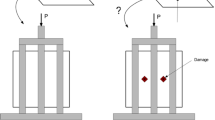Abstract
Based on a low-velocity impact test, four main modes of low-velocity impact damage, including matrix cracking, delaminating, fiber failure and matrix crushing, are taken into account. By using the proper failure criterion, the lowvelocity impact damage of z-pin reinforced laminates can be realized. The results of FEM simulation, which indicate that a z-pin makes the area of delamination reduced by approximately 50%, are in good agreement with the experimental C-scan results.
Similar content being viewed by others
Reference
D. J. Barrett, The mechanics of z-fiber reinforce ment, Composite Structures, 36 (1996) 23–32
Y. C. Gao, Damage modeling of fiber reinforced composites,Theo. Appl. Frac. Mech. 11 (3) (1989) 147–155.
M. Grassi, X. Zhang, M. Meo, Prediction of stiffness and stresses in z-fiber reinforced composite laminates,Composites: Part A. 33 (2002) 1653–1664.
Y. C. Gao, Y. W. Mai, B. Cotterell, Fracture of fibre reinforced material,J. Appl. Math. Phys. 39 (1988) 550–572.
N. Sridhar, Q. D. Yang, B. N. Cox, Slip, stick, and reverse slip characteristics during dynamic fiber pullout,Journal of the Mechanics and Physics of Solids. 51 (2003) 1215–1241.
C. T. Sun, J. E. Grady, Dynamic delamination fracture toughness of a Graphite/epoxy laminate under impact.J. Composite Science and Technology. 31 (1988) 55–72.
F. Collombet, X. Lalbin and J. L. Lataillade, Impact behavior of laminated composites: physical basis for finite element analysis.Composites Science and Technology. 58 (1998) 463–478.
J. P. Hou, N. Petrinic, C. Ruiz and S. R. Hallett, Prediction of impact damage in composite plates,Composite Science and Technology. 60 (2000) 273–281.
L. Daudeville, O. Allix, and P. Ladevèze, Delamination Analysis by Damage Mechanics: Some Applications, Composites Engineering, 5(1) (1995): 17–24.
ABAQUS Analysis User’s Manual, v6.5, ABAQUS INC., USA, (2005).
P. P. Camanho, C. G. Dávila and D. R. Ambur, Numerical Simulation of Delamination Growth in Composite Materials, NASA/TP-2001-211041.
C. G. Dávila and P. P. Camanho, Analysis of the effects of residual strains and defects on skin/stiffener debonding using decohesion elements, NASA-AIAA-2003-1465.
M. L. Benzeggagh and M. Kenane, Measurement of Mixed-Mode Delamination Fracture Toughness of Unidirectional Glass/Epoxy Composites with Mixed-Mode Bending Apparatus,Composites Science and Technology. 56 (1996) 439–449.
Author information
Authors and Affiliations
Corresponding author
Rights and permissions
About this article
Cite this article
Teng, J., Zhuang, Z. & Li, B. A study on low-velocity impact damage of Z-pin reinforced laminates. J Mech Sci Technol 21, 2125–2132 (2007). https://doi.org/10.1007/BF03177472
Received:
Revised:
Accepted:
Issue Date:
DOI: https://doi.org/10.1007/BF03177472




